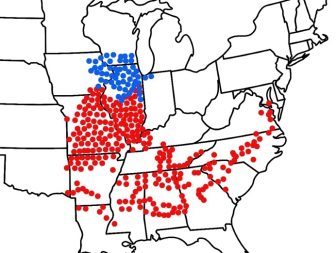
Periodical cicadas emerge from the ground in large numbers every 13 or 17 years depending on the brood. In 2024 both broods will emerge. Image: Gene Kritsky
By Clara Lincolnhol
Billions of cicadas will emerge in the Midwest this spring during a once-in-a lifetime event, but you may want to keep them off the menu.
Research shows the insects contain surprisingly high levels of mercury.
And cicada consumption becomes especially trendy when broods erupt in large numbers, said Beth Czerwony, a registered dietician with the Cleveland Clinic Center for Human Nutrition.
Most often cicadas, which are related to lobsters and shrimp, are used in deep fried dishes, or are sautéed similarly to seafood, she said. Numerous websites advertise recipes involving the insects. Montclair State University describes cicada chocolate fondue. The Food Network says the bugs have “a nutty flavor and shrimp-like quality.” But cicadas have no formal nutrition data, Czerwony said.
And a study from the University of Cincinnati Ohio found mercury levels in some cicadas approaching government consumption warnings for fish. Mercury concentration ranged from 0.01-4.46 parts per million, depending on where the bug was found. The Food and Drug Administration has set a maximum permissible level of mercury concentration in food as 1 part per million.
Due to their years-long underground feeding, cicadas are susceptible to accumulating toxic metals such as mercury, said Gene Kritsky, an entomologist at Mount St. Joseph University and the author of A Tale of Two Broods.

A cicada molts out of the nymph stage and becomes a winged adult. Image: Gene Kritsky
Metals in the soil are absorbed by tree roots. Cicadas feed on the fluids in those roots and take in those metals.
“They’re feeding on this very liquid diet and it’s going to pick up minerals and things in the soil,” said Kristky, a biology professor.
Consumption of mercury is dangerous for human health. “The first thought was, you don’t want to eat a lot of these things,” he said, after seeing the study’s test results.
Mercury is a neurotoxin, said Celia Chen, an ecotoxicologist research professor at Dartmouth College. It causes irreversible damage to the brain, lungs, nervous system and the cardiovascular system. Young children, infants and developing fetuses are most susceptible to mercury poisoning, she said.
Mercury is transported through the air. Factories, power plants and mines burn coal, wood, oil or waste containing mercury, releasing it into the air. This influences the amount of the metal in the nearby soil according to the United States Environmental Protection Agency.
“It can get into the soil from emissions that are then deposited locally,” Chen said.
But mercury can also travel long distances.“It can get into the soil from far away sources too since it’s atmospherically transported,” she said.
In addition to bioaccumulation concerns, people with shellfish and crustacean allergies shouldn’t eat the cicadas because they contain the protein tropomyosin–which is the allergy’s trigger, according to the Asthma and Allergy Foundation of America.
Cicadas are otherwise harmless. They lack a stinger, don’t bite and the worst they can do is pee on you, Kritsky said.
Periodical cicadas spend almost their entire lives underground. Brood XIII, present in northern Illinois, southern Wisconsin and parts of Indiana and Iowa, emerges every 17 years. Brood XIX emerges in southern Illinois, Missouri and many other southeastern states every 13 years.

Cicada Brood XIII indicated by the blue dots, and Brood XIX, indicated by the red dots, will both emerge in 2024. The last time this happened was in 1803. Image: Gene Kritsky
Michigan may see a few Brood XIII cicadas near its southwestern border, according to MSU Extension. Other Great Lakes states like Ohio and Minnesota will not see any periodical cicadas this year.
Although some states will not see the periodical cicadas this year, all will see their usual annual cicada species.
The last time both periodical broods overlapped was 221 years ago in 1803. Both broods’ brief time above ground–about five weeks– is spent mating and laying eggs, Kritsky said.
Brood XIII is expected to emerge late May to early June and Brood XIX in mid to late May. Emergence correlates with soil temperatures reaching and staying 64 degrees Fahrenheit, he said.
Those living where periodical cicada broods are expected should download the app Cicada Safari to report the insects they see, Kritsky said. This helps scientists better understand the limits of each brood’s range.